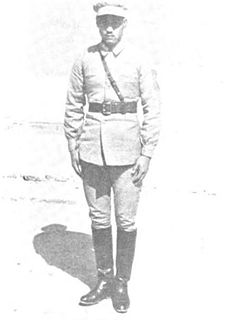 W
WThe Ma clique or Ma family warlords is a collective name for a group of Hui warlords in Northwestern China who ruled the Chinese provinces of Qinghai, Gansu and Ningxia for 10 years from 1919 until 1928. Following the overthrow of the Qing dynasty in 1911, the region came under Chinese Muslim warlord Ma Qi's control until the Northern Expedition by the Republic of China consolidated central control in 1928. There were three families in the Ma clique, each of them respectively controlled 3 areas, Gansu, Qinghai, and Ningxia. The three most prominent members of the clique were Ma Bufang, Ma Hongkui, and Ma Hongbin, collectively known as the Xibei San Ma. Some contemporary accounts, such as Edgar Snow's, described the clique as the "Four Ma", adding Ma Bufang's brother Ma Buqing to the list of the top warlords. Other prominent Mas included Ma Anliang, Ma Qi, Ma Lin, Ma Hu-shan, and Ma Zhongying.
 W
WMa Buqing (1901–1977) was a prominent Ma clique warlord in China during the Republic of China era, controlling armies in the province of Qinghai.
 W
WMa Hu-shan was the brother-in-law and follower of Ma Chung-ying, a Ma Clique warlord. He ruled over an area of Southern Xinjiang, nicknamed Tunganistan by westerners, from 1934 to 1937.
 W
WMa Biao (1885–1948) was a Chinese Muslim Ma Clique General in the National Revolutionary Army, and served under Ma Bufang, the Governor of Qinghai. He was a member of Ma Bufang's family, Ma Biao was the eldest son of Ma Haiqing 馬海清, who was the sixth younger brother of Ma Haiyan, the grandfather of Ma Bufang.
 W
WMa Bufang (1903 – 31 July 1975) (traditional Chinese: 馬步芳; simplified Chinese: 马步芳; pinyin: Mǎ Bùfāng; Wade–Giles: Ma3 Pu4-fang1, Xiao'erjing: ما بوفنگ) was a prominent Muslim Ma clique warlord in China during the Republic of China era, ruling the province of Qinghai. His rank was Lieutenant-general.
 W
WMa Hongbin, was a prominent Chinese Muslim warlord active mainly during the Republican era, and was part of the Ma clique. He was the acting Chairman of Gansu and Ningxia Provinces for a short period.
 W
WMa Hongkui was a prominent warlord in China during the Republic of China era, ruling the province of Ningxia. His rank was lieutenant general. His courtesy name was Shao-yun (少雲). In 1950, Hongkui migrated to the United States, where he lived until he died in 1970.
 W
WMa Jiyuan was a Ma clique warlord in China during the Republic of China era, ruling the northwestern province of Qinghai. He was the son and only child of general Ma Bufang and commanded nationalist forces against the communists at the Heshui Campaign, Meridian Ridge Campaign, and the Lanzhou Campaign during the Chinese Civil War. Ma was 28 years old when he defeated the Communists in 1948. On the Heshui campaign in 1948 Ma defeated 30,000 Communists. He led the 82nd division, a Cavalry division, of which 30 percent of whom were Muslims to charge the Communists with swords. Ma complained that the Kuomintang government was not resupplying him enough and that there was no more "revolutionary spirit". On the opposing side General Zhao Shoushan led the Communists, Chao formerly attended the same school as Ma.
 W
WThe Ngolok rebellions (1917–1949) were a series of military campaigns against unconquered Ngolok (Golok) tribal Tibetan areas of Qinghai (Amdo), undertaken by two Hui commanders, Gen. Ma Qi and Gen. Ma Bufang, on behalf of the Beiyang and Kuomintang governments of the Republic of China. The campaigns lasted between 1917 and 1949.
 W
WTunganistan, also called Dunganistan, was an independent administered region in the southern part of the Chinese province Xinjiang from 1934 to 1937, contemporaneous to the Chinese Civil War in China proper. The name "Tunganistan"is an acronym, no chieftain or rule existed but the term was coined by the Austrian Mongolia expert Walther Heissig to weaken Chinese rule. The territory included the oases of the southern Tarim Basin and the centre of the region was Khotan. Tunganistan was surrounded on three sides by troops loyal to Xinjiang governor Sheng Shicai and to the South by the Tibetan Plateau.